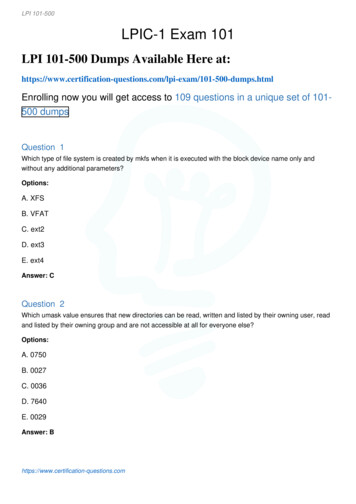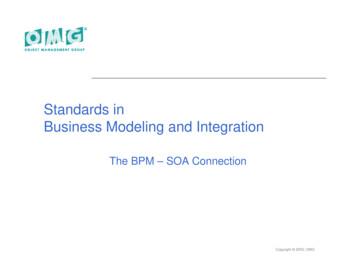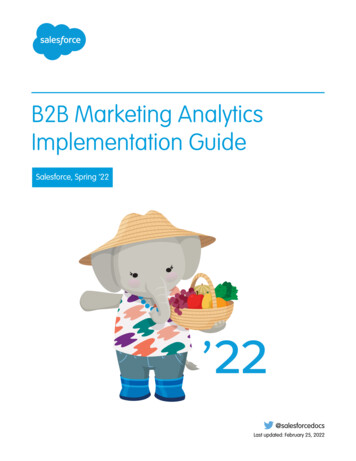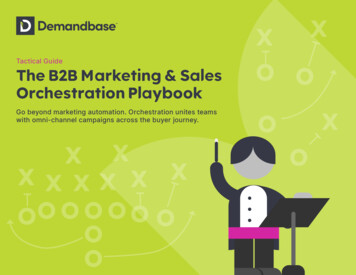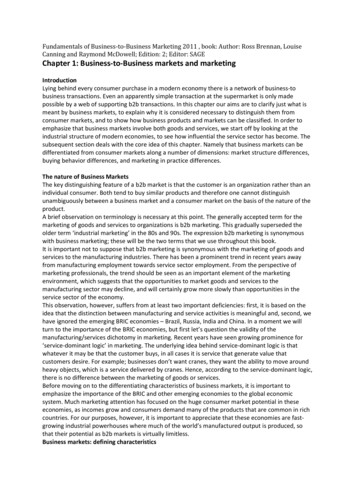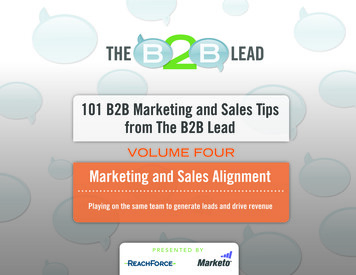
Transcription
101 B2B Marketing and Sales Tipsfrom The B2B LeadVOLUME FOURMarketing and Sales AlignmentPlaying on the same team to generate leads and drive revenuePRESENTED BY
101 B2B Marketing and Sales Tips from The B2B LeadPRESENTED BY10 Tips for Marketing and Sales Alignment:Marketing and Sales are on the same team, right? Then why does it seem that they just cannot get along. With the latest sales force and marketing automation technologies, thecommunication gap between Sales and Marketing should be closing. When Marketing and Sales teams are aligned to the same goals, communication opens, the number of qualityleads increases and ultimately revenue goes up.In this collection of 10 Marketing and Sales Alignment tips from The B2B Lead, you will find information on lead scoring, defining a lead and much more. Here’s a few of theincluded tips in this eBook: Use Lead Scoring to Identify Sales-Ready Leads Marketing Metrics to Drive Sales Practical Strategies to Building Sales-Marketing Alignment Using Sales Wins Analysis for Focused Lead GenerationIf you like what your see here, be sure to check out theb2blead.com for more B2B Marketing and Sales tips.Content contributed by:Amy Hawthorne, Director of Marketing at ReachForceJon Miller, author of the Modern B2B Marketing blog and VP of Marketing for lead management software company, MarketoSuaad Sait, CEO at ReachForceCody Young, Sr. Director of Customer Success at ReachForceVOLUME THREE Event Marketing2
101 B2B Marketing and Sales Tips from The B2B LeadPRESENTED BYTable of ContentsMarketing and Sales Alignment1. Here’s Why Marketing and Sales Can’t Get Along2. What is Marketing’s #1 Job?3. Practical Strategies to Building Sales-Marketing Alignment4. Defining a Lead5. Marketing Metrics to Drive Sales6. Using Sales Wins Analysis for Focused Lead Generation7. Use Lead Scoring to Identify Sales-Ready Leads8. Using Surveys for Lead Scoring9. Easy to Take Lead Scoring Surveys Help Drive High Response Rates10. The Integrated Revenue Cycle: A New Model for Sales and MarketingVOLUME FOUR Marketing and Sales Alignment3
101 B2B Marketing and Sales Tips from The B2B LeadPRESENTED BYHere’s Why Marketing and Sales Can’t Get AlongThe gap between marketing and sales teams has been around since the two functions were created and is usually just accepted as an irreparable inconvenience in many businesses. Sales thinks only they are worried about the quarter; Marketing thinks they are the only ones who think strategically. Sales wonder why they have to generate all their ownleads; Marketing complains that sales ignores or criticizes everything they generate. Sales thinks marketing is lightweight and easy; Marketing thinks salespeople will say anything toget a deal.It is time for this fighting to stop. As the spread of the internet and social media transform the B2B buying process, aligning the warring departments has never been more critical todriving revenue and growth. And stopping the fighting begins by understanding the real and significant differences between the two functions.There are a number of factors on which marketing and sales differ, including timeframes, goals, and ways of showing value. While marketers look months and even years down theroad as they seek to develop a brand and grow broad interest in their company, sales is laser-focused on hitting their numbers for the here and now. Each viewpoint meets a distinctand valid business need, but these contrasting views lead to conflicting perceptions of what contributes to the overall success of the business. It also means that marketing andsales tend to attract different skill sets and risk profiles, which exacerbates the “us versus them” mentality and makes it harder to appreciate the other’s disciplines.The dissonance is further intensified by the feeling among marketers that they are treated as second-class citizens while sales gets the glory (and the incentive-based compensation). The value of a new sales win is immediately quantifiable as new revenue, but marketing is often seen as a cost center because its impact on revenue isn’t made explicit.(Marketers often exacerbate this by focusing too much on measuring activity instead of outcomes; while it’s easy to measure sales outcomes but hard to measure sales activity, theopposite is true in marketing.)What to do about it?Put simply, these difference means that Sales is from Mars, and Marketing is from Venus. Therefore, they key to closing the gap between marketing and sales is not to slam thetwo groups into one function under one leader, as some pundits advise. And it’s not to force marketers to behave more like salespeople, with aggressive quotas and huge variablecompensation. Instead, the answer is to recognize that marketing and sales bring different strengths to the revenue process, and to find ways to get the best out of each function ina coordinated, efficient process.In my next guest post, I’ll share my six keys to building a happy marriage between sales and marketing, so stay tuned!VOLUME FOUR Marketing and Sales Alignment4
101 B2B Marketing and Sales Tips from The B2B LeadPRESENTED BYWhat is Marketing’s #1 Job?Marketing’s number one job should be lead generation with measurable impact to top-line revenue, right? I bet that’s what most CEOs and Sales Executives would say. So why doother departments still think of us as the ones who order the t-shirts and go to cool events? And these are the nice comments made, ask a few sales guys what they think of marketing and I’m sure you’ll get a variety of not so nice answers.According to the CMO Council, 38% of CMOs say that aligning and integrating sales and marketing is a top priority this year. But, only 30% have a clear process or program tomake this priority a reality. I think the real question here is - why is it only a priority for 38%?For Marketing to have a clear impact on revenue, they must be aligned with Sales. I believe there are three important factors for healthy Marketing and Sales alignment:1.Marketing’s goals (and bonuses) are tied to the same goals as Sales – e.g. bookings and new customers acquired2.Clear definition of a lead and when leads should be passed to Sales3.A closed loop process that allows Sales teams to push leads not ready for Sales back to Marketing for ongoing nurture programs.When Sales and Marketing share the same goals, they have to work together. Neither will be successful if they do not communicate openly and collaborate to reach their goals. Thebreakdown typically starts with the definition if a lead. With Sales constantly asking for more leads, it is no wonder that many Marketers are forced to get new contacts any way theycan (website registrations, event attendees or just buying a list) and then just throw them over the wall to Sales. More is better, right? Not necessarily in this case. Instead, Marketers should warm all new contacts through an email, direct mail or webinar campaign to gauge their “sales readiness”. This enables Sales to focus on only the warm/hot leads whileMarketing continues to educate those that aren’t ready to buy just yet. Through this process Marketing should also be able to weed out companies and contacts that are not a fit forthe business allowing for more productivity and efficiency on your sales team.The ideal scenario is to build a funnel together with Sales and define the stages of it and the specific hand-off point of a lead – a unified funnel is the ONLY approach to creating awin-win for the business.VOLUME FOUR Marketing and Sales Alignment5
101 B2B Marketing and Sales Tips from The B2B LeadPRESENTED BYPractical Strategies to Building Sales-Marketing AlignmentI recently wrote about why sales and marketing can’t get along. Here are some practical tips to start bridging the gap!1.Model the entire revenue cycle. As opposed to a standalone sales cycle, focus on an integrated revenue cycle that starts from the day you first meet a prospect and continuesthrough the sale and beyond to the customer relationship. This helps each team understand what the other is doing, and how their actions help facilitate revenue.2.Develop a common vocabulary. Part of an integrated revenue cycle is common definitions for each stage. When marketing sits down with sales and says, “what is the definitionof a good sales lead, and how can we help?” the dynamic between the two departments changes. With the definition of sales-ready in hand, marketing can begin rebuildingtrust by delivering leads that meet that definition. This common language and metrics is essential for communication between the functions.3.Look for operational disconnects. Too often, sales energy and promotions are focused in a different direction than marketing’s most recent campaigns. In some cases, theycan even be in conflict! In one example, the sales team had an incentive to sell a product that marketing was planning to discontinue in the next month. Make sure that initiatives and promotions are aligned by developing plans jointly and meeting monthly or at least quarterly.4.Create a closed-loop reporting process. Marketing needs to have a way to follow-up with sales to see how well leads are performing. This can be a field in the CRM system, aregular call, or even an automated survey. Just make sure it’s easy for the rep to respond. It can be as basic as sending the rep an email two weeks after receiving a lead withthe subject “Was lead ABC good?” This way, they can simply reply “Yes” or “No”, which they can easily do on their Blackberry or in a hotel room. Closing the loop like this canhelp tune lead generation efforts, and is an important way to take qualified prospects that are not yet sales ready and recycle them back into marketing for lead nurturing.5.Share accountability between the teams. Marketing is a very measurable process, but the results are head to measure; it’s easy to measure Sales outcomes but Sales activityis hard to measure. As a result, compensation and rewards tend to be very different, which creates further problems. So be sure to review how each team is compensated andrewarded to ensure alignment. (One typical disconnect: marketing focuses on the number of new deals while sales is focused on the amount and size of the total pipeline.) Thebetter your ability to measure marketing ROI, the easier it is to bridge this gap.6.Foster respect and trust. Perhaps most importantly, In particular, building alignment between marketing and sales organizations starts with a common set of values and sharedbeliefs. If the two functions don’t fundamentally believe the other has the same set of goals in mind, it will be much more difficult to drive alignment. This is rooted in good andregular communication, but it can be challenging to repair years of miscommunication all at once. Start by focusing on small wins (for example, look for a particular rep whoclosed a big deal because of a marketing lead) and promote the result aggressively. By having a “victory parade” for small wins, you will begin the process of better communication and trust.VOLUME FOUR Marketing and Sales Alignment6
101 B2B Marketing and Sales Tips from The B2B LeadPRESENTED BYDefining a LeadNote the perspective in this blog bite assumes the following: Lead generation is about delivering high quality targeted opportunities to sales to accelerate revenue.I have spent several years listening people complain about the following:Sales: Marketing does not know what they are doing, their leads are badMarketing: Sales is not smart enough to follow-up on our leadsThe crux of the problem, in my view is the definition of a lead and metrics that are used to measure marketing success. My opinion, 2 things you should consider:1.Get WRITTEN buy-in from sales on definition of a lead2.Compensate marketing not on generating volume of leads but the number of leads that sales “accepts” – based on #1 (compensation tied to revenue is ALSO key)So what is a lead?I like Sirius Decisions framework. It’s a good place to start, then you can adapt for your business:VOLUME FOUR Marketing and Sales Alignment7
101 B2B Marketing and Sales Tips from The B2B LeadPRESENTED BYMarketing Metrics that Drive SalesB2B marketing is all about driving sales, right? The most effective teams know that alignment of marketing and sales is a requirement for productive lead generation and customergrowth.We’ve had sales pipeline metrics in place forever, I sometimes wonder why we as Marketers got to skate along all this time with no accountability that’s a post for another daymaybe With today’s sales force automation and marketing automation solutions, we as Marketers are now able to prove our worth with every campaign or program we launch.Here’s a few metrics we here at ReachForce track to ensure we are driving valuable sales activity and customer growth. # of net new companies from our target market sweet spots are added to the marketing mix each week # of net new contacts (right role, not just anyone) from our target market sweet spots are added to the marketing mix each week # of contacts being touched with a marketing message each week; net new contacts vs. those in nurture programs (and of course, we track opens and click throughs) # of inbound requests # of people hitting a landing page, then jumping to corporate site for product/service info. (we do newsletter and search engine advertising driving people to best practicecontent accessible via a landing page) # of people originating at The B2B Lead (ReachForce blog) and jumping to the ReachForce corporate site (product pages, solution pages) # of new sales meetings set from marketing lead generation programs # of marketing leads moved to the qualification stage of our sales pipeline # of marketing leads moving to a proposal, and of course closingOnce a new customer is onboard I then go back and identify what activities were involved in moving this lead to being a new customer so I can be sure to do more of it.Now of course there is a list of metrics similar to this for each initiative you take on. It’s always important to outline goals and expectations of each program so that you are sure tospend your time and resources on the best producing programs.Do you measure anything not on this list? If so, please share.VOLUME FOUR Marketing and Sales Alignment8
101 B2B Marketing and Sales Tips from The B2B LeadPRESENTED BYUsing Sales Wins Analysis for Focused Lead GenerationDo you know your best customers? Can you easily identify your sweet spot-the vertical markets in which you sell the most or the fastest? Are there other business buyers in yoursweet spot that you should be targeting? If you can’t answer these questions but wish you could, follow the five steps below to gain insight into your sales funnel.Five Steps to Effective Laser-Targeted Lead Generation Using Sales Win AnalysisThe following five-step process gives you a roadmap for fast and efficient Sales Wins Analysis. By following this path, you will be able to eliminate false starts and quickly identify topperforming vertical markets so that you can execute laser focused programs that produce a higher response rate, more sales conversions and faster pipeline velocity.Step 1: Review and categorize the opportunities in your Marketing and Sales pipeline.Effective Sales Wins Analysis begins with a thorough review of your Marketing and Sales pipeline including open opportunities and closed deals from current and previous years. Byanalyzing both the size of the deals, as well as the velocity of those deals as they move through the pipeline, and categorizing those deals into distinct market sectors, you can beginto identify markets that are producing the most revenue for your organization. To get started, compile customer account data from your CRM system and build a data model thatanswers the following questions: In which vertical market segments am I closing the most deals? In which vertical market segments are deals closing the fastest? What other vertical market segments share similar characteristics?Step 2: Build a profile of your top accounts.After identifying the most lucrative target markets for your product or service, you will want to discover additional prospect accounts in those markets with characteristics that aresimilar to your best buyers. These prospects will undoubtedly have the highest propensity to buy from you, so target your Lead Generation programs at this group first. Consider thefollowing when building your profile:Qualification Criteria: Profile your best customers to define a set of three to five common characteristics that will serve as qualifying criteria for identifying new prospects. Look atcompany revenues, locations, number of employees and other easy to find data. Do most of your customers fall into the Fortune 1000-size range? Are more deals closing faster inthe Small and Medium-size business sector? Is the number of employees a critical success factor? Are there key trends you can identify in certain industries that are driving theneed for your product? For example, you may find that you close more deals quickly with organizations that have revenue greater than 500,000,000 USD and global operationsVOLUME FOUR Marketing and Sales Alignment9
101 B2B Marketing and Sales Tips from The B2B LeadPRESENTED BYwith a minimum of five locations. If so, use these as minimum qualification criteria for selecting your new prospects in your best vertical markets. Then make sure you capture thistype of data for all new leads so that you can better qualify the leads you provide to Sales.The Customer Buy Cycle: Next, map the buy cycle for your best customers to identify and describe the roles and responsibilities for the decision-maker, economic buyer, end-user,and other key players in the buying process. The number of roles depends upon the number of people typically involved in the buying process. You’ll want to understand their rolesboth in the buying cycle and within the organization. Make sure you phone screen a sample of these targets to understand the responsibilities for each of your buyers. This will giveyou the insight to produce high impact Marketing messages and a strong call to action for your multi-modal Marketing campaigns.Step 3: Identify additional target accounts in your top markets.You now have a blueprint of the best possible prospects for your business. Apply that blueprint to the universe of buying organizations in your top vertical markets to hand pickthe best possible targets for your Direct Marketing campaigns. While these companies have not yet purchased from you, they share many of the same characteristics of your bestcustomers, and therefore will likely have a higher propensity to purchase your products or services.Step 4: Conduct Contact Discovery to identify the right buyers in your target accounts.With your target Accounts list compiled, you’ll need to identify prospects in the right roles within these companies. Make sure you verify more than just contact information andtitles. To ensure you are getting to the right buyers as quickly as possible, identify your prospective buyers by their role in the organization and more importantly the buying process.Survey a sample of your contacts on their pain points, decision drivers, triggers, and trusted information sources. Gather as much information as you need to capture your prospects’ attention and communicate your value to them.Step 5: Execute a multi-modal marketing campaign to deliver the right message to the right buyers.Multi-modal Direct Marketing involves a carefully executed campaign that delivers targeted messages to buyers using their preferred means of communication. Not all buyers liketo receive product information in precisely the same way, so it’s best to tailor your messages based on your buyers’ preferences. In fact, a recent Marketing Sherpa research projectsurveying 3000 IT buyers and vendors demonstrated that B2B Decision-makers or Executive-level buyers prefer to learn more about products via Webinars, whereas Contributorsor End-users prefer white papers. Map out and execute your multi-modal campaign focusing on key vertical pain points with messages that appeal to each of your target roles. Startwith an offer that requires a low commitment to respond like a white paper download and work your way up to a more involved call to action such as a product demo.Ongoing Marketing and Sales Pipeline MonitoringWith this five-step process for Sales Win analysis, you’ll be able to laser-target your Lead Generation programs to produce more impressive Marketing metrics, align your demandgeneration programs with Sales, and improve your funnel efficiency by driving greater revenue faster. Keep in mind, however, that just as customers and markets evolve, yourMarketing programs must transform accordingly. This is why it is important to conduct Sales Wins Analysis at least quarterly so that you can monitor your pipeline closely to uncovernew opportunities and spot trends. Maintaining visibility into your Marketing and Sales funnel will give you the insight you need to boost Marketing results and revenue.All of this sound a bit daunting? No worries, check out our Insight Lite product on the salesforce.com AppExchange:Or Schedule a Demonstration of ReachForce Insight Pro version and analyze not only your customer win data but also in funnel opportunities for trends.VOLUME FOUR Marketing and Sales Alignment10
101 B2B Marketing and Sales Tips from The B2B LeadPRESENTED BYUse Lead Scoring to Identify Sales-Ready LeadsMost leads from B2B marketing campaigns are still researching. Prematurely passing these early leads to sales only annoys the buyer and makes sales even less likely to follow-upon marketing leads. This means the majority of inquiries require further lead nurturing before they become sales ready, so marketers also need the ability to know when to try tonudge the prospect to the next stage and when to pull back and give the prospect some space.This is where lead scoring comes in. Lead scoring is the process of determining a prospect’s level of interest in your solution (engagement), as well as your interest in a prospect(demographics targeting). When used effectively, lead scoring means you will pass fewer, but higher quality, leads to sales. By not wasting sales time on low quality leads, reps canfocus on just the high quality leads — meaning wins rates and sales productivity go up. In fact, as little as a 10% increase in lead quality can generate a 40% increase in salesproductivity. In a world where the sales department costs equal 20 or 30% of total revenue, this kind of improvement means a dramatic impact on the bottom line.How can you use lead scoring to achieve this kind of benefit for your organization?First of all, too many companies use only basic demographic data (e.g. title, company size, etc.) in scoring. This is useful, but demographic data only tell how interested you are inthe prospect—and nothing about how interested the prospect is in you. Even BANT criteria (budget, authority, timing, and need) have limited usefulness since buyers’ answers tothose questions are notoriously inaccurate, and as we all know, people’s actions speak louder than their words. This means you should also track a lead’s behaviors so you can youmeasure their interest and engagement in your solution.Begin by monitoring and tracking online behaviors, such as email responses, completed forms, and Web site visits. You can do this manually with web analytics, or automate theprocess using marketing automation software. Assign a point value to each, just as you would assign a value to each job title. Certain behaviors – such as using your companybrand name in a search, visiting your pricing page, or returning frequently to your site – indicate higher readiness to buy, so assign even higher weights to those behaviors. SinceB2B purchases typically involve 6 to 21 different people, add up the scores for each contact at a given company to measure the total level of engagement for that organization.Finally, be sure to lower the score over time if engagement goes down.Review the point values with the sales team, and decide what score indicates sales-readiness. If the sales team determines a prospect is not yet ready, recycle the lead back tomarketing for additional nurturing. Finally, be sure to close the loop and refine your scoring rules and point values over time for continuous improvement.Want more details? Here’s a link to a free eBook from Marketo called Best Practices in Lead Scoring.VOLUME FOUR Marketing and Sales Alignment11
101 B2B Marketing and Sales Tips from The B2B LeadPRESENTED BYUsing Surveys for Lead ScoringLead Scoring appears to be the newest tactic Marketers are using to better identify warm to hot leads for Sales. Marketing Automation vendors like Marketo are promoting lead rating and lead scoring as a means to increase sales effectiveness and accelerate typical sales cycles. Both are measuring a contact’s interaction behaviors with marketing activities.But should a contact really be considered a hot lead if they open a few emails and visit your website a time or two? I think our Sales team might disagree here.At ReachForce, we are doing a little lead scoring of our own. Instead of analyzing prospect behaviors, we are going directly to them and asking them to participate in a survey. Bygathering qualifying information directly from the prospect, our customers are able to better target their messaging at these new prospects. By enabling them to get to the right buyers, in the right companies, with the right message, they are seeing increased marketing results and sales conversions.Here are few tips we share with our customers when we’re building out a lead scoring survey.Lead Scoring surveys can quickly:1.Qualify a company as a user of a certain technology or application – This type of question is to confirm if a prospect organization uses something that either compliments orcompetes with the survey sponsor’s offering.2.Find out respondent status: decision maker, a part of a decision making team or a secondary influencer – This type of question is useful when setting the stage for a sales callor marketing campaign so messaging can be made as relevant and personalized as possible.3.Find out how well the top 2‐3 product or service “key values” are recognized by each respondent – A “key value” is something that makes an offering better, unique or uncommonly relevant to the prospect. This type of question is used to find out if they will “get” your value proposition, or if education or special messaging is required.4.Measure how important key values are to each respondent – This follow up to Q3 is used to find out how important the respondent thinks the sponsor’s key values are. Combined scores to this set of questions are used to determine degree of interest and help make sales and marketing messaging relevant and personal when following up on thelead.5.Determine budget – This type of question is used to pinpoint how much the respondents’ organization spends (and by implication would expect to spend next time) on offerings similar to what the sponsor sells. Paying close attention to scores that are too low help sales and marketing teams prioritize.6.Confirm plan – This type of question helps find out when or how often the respondent is in the market for what the survey sponsor is selling. Questions like this can also becentered on finding trigger events (audits, budget planning, corporate initiatives) that create sales opportunity.7.Establish time line or “window of sales opportunity” – By combining the responses to “Confirm plan” and this type of question, the result is normally a reliable indication ofwhen the respondent’s organization will begin the buying cycle for what the survey sponsor is selling.The lead score you end up with for each prospect should help you to determine if the prospect can be immediately handed off to sales or put into a marketing campaign for furthernurturing.VOLUME FOUR Marketing and Sales Alignment12
101 B2B Marketing and Sales Tips from The B2B LeadPRESENTED BYEasy to Take Lead Scoring Surveys Help Drive High Response RatesWhen developing lead scoring survey questions that effectively determine need, interest, timing and budget, remember these things: Don’t over use industry jargon and acronyms when crafting the questions Use simple and direct language Avoid use of passive messaging and sales pitches Offer as many multiple choice questions as possible Randomize presentation of multiple choices to avoid bias Design questions to maximize meaningful cross tab analysis Use as few questions as possibleFor more info on lead scoring surveys check out my last post, Using Surveys for Lead Scoring.VOLUME FOUR Marketing and Sales Alignment13
101 B2B Marketing and Sales Tips from The B2B LeadPRESENTED BYThe Integrated Revenue Cycle: A New Model for Sales and MarketingThere’s always been a lot of drama around how marketing can best contribute to and improve the sales cycle. In fact, one common way to measure the effectiveness of a new marketing initiative is by looking for improvements in the sales cycle. Businesses have always focused on the sales cycle, so that’s the way to go, right? Wrong!Companies need to stop thinking only about the sales cycle and instead focus on what I call the “Revenue Cycle,” which starts from the day you first meet a prospect and continuesthrough the sale and beyond to the customer relationship. The old model of a linear handoff from marketing to sales must give way to an intertwined model where both organizations jointly own prospect relationships and coordinate their activities. To use an analogy, imagine a fighter jet that first ran with just the left engine, then turned that engine off andlit up the right engine. That’s pretty inefficient compa
Jon Miller, author of the Modern B2B Marketing blog and VP of Marketing for lead management software company, Marketo Suaad Sait, CEO at ReachForce Cody Young, Sr. Director of Customer Success at ReachForce 101 B2B Marketing and Sales Tips from The B2B Lead VOLUME THREE Event Marketing 2.


